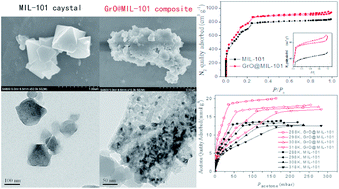A novel MOF/graphene oxide composite GrO@MIL-101 with high adsorption capacity for acetone
Abstract
A novel composite material GrO@MIL-101 was synthesized using a solvothermal synthesis method. Then the parent materials (MIL-101 and graphene oxide) and the GrO@MIL-101 were characterized using SEM, TEM, XRD, nitrogen sorption, and Raman. The acetone isotherms on the GrO@MIL-101 and MIL-101 were measured separately. The isosteric heat of adsorption and the desorption activation energies of acetone on the two samples were estimated. The results of characterization confirmed the formation of well-defined GrO@MIL-101 with higher surface area and pore volume compared to the MIL-101, and the crystal size of the MIL-101 in the composite was smaller than that of the parent MIL-101. The acetone isotherms on the GrO@MIL-101 were much higher than those on the MIL-101. The acetone adsorption capacity of the GrO@MIL-101 was up to 20.10 mmol g−1 at 288 K and 161.8 mbar, having an increase of 44.4% in comparison with the MIL-101. The desorption activation energy of acetone on the GrO@MIL-101 was higher than that on the MIL-101, indicating the stronger interaction between acetone molecules and the GrO@MIL-101. Consecutive cycles of acetone adsorption–desorption showed that the desorption efficiency of acetone on the GrO@MIL-101 can reach 91.3%. Acetone adsorption on this composite material was highly reversible.


 Please wait while we load your content...
Please wait while we load your content...